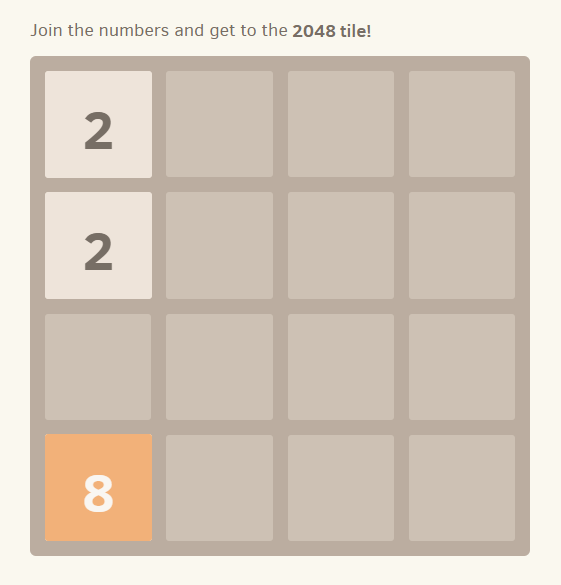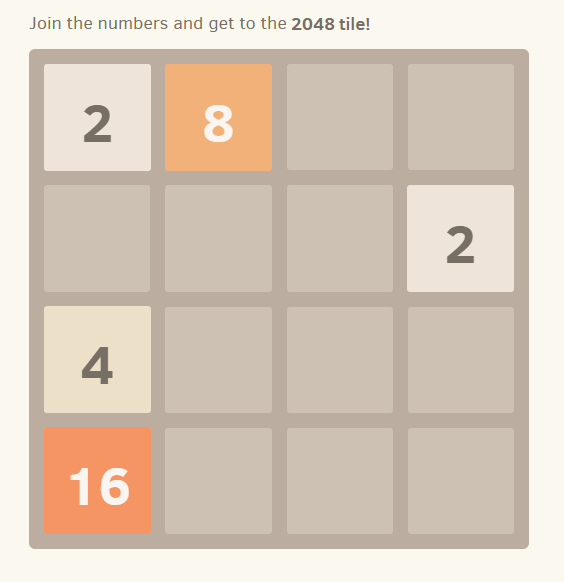Learn About Exponents With 2048
Recently, one of my kids has been really enjoying playing the game 2048. We haven’t covered multiplication yet, at least not through the implementation of any coursework, but when I asked them what 2 to the power of 4 was, they answered without hesitancy, “SIXTEEN!” That was the moment I realized that I had to share this example of teaching math through videogame-schooling.
For those who are unaware, it is a surprisingly simple, and yet captivating puzzle game, where you slide tiles with numbers in the power of 2 vertically or horizontally to stack them, and each time you stack a number, it doubles.
2+2=4, 4+4=8, 8+8=16, and so on - you get the idea.
The ultimate goal with this game is to reach 2048, which becomes more and more challenging as you attempt to shuffle the tiles back and forth as the board quickly starts to fill up. You can continue playing the game after you reach 2048, but if you give it a shot, you will quickly learn that just reaching 2048 is challenging on its own.
The fact that the viral game was created in a single weekend by a 19 year old who wanted to see if he could code a game from scratch is on its own incredibly impressive. What this simple, free-to-play game can do to help you explain a concept to children that can be confusing makes it invaluable in a tech-friendly homeschool.
What makes teaching the concept of exponents a bit challenging is having to explain the difference between a number (in this case 2) times another number (which they learn either through methods such as multiplication tables, hopping around on a hundreds chart, or skip-counting), as opposed to that same number to the power of another number.
The concept of multiplication is fairly easy to grasp when they realize they’ve been slowly introduced to it over several years through learning about addition, both through life experience as well as any intentional math lessons. You might walk the child through this experience: you have two toy cars, then your dad gives you two new toy cars, then mom comes and gives you two more toy cars - how would you write this out to show how many cars you got? The child who has been learning basic arithmetic might write 2 (mine) + 2 (from dad) + 2 (from mom). And you might reply, that’s correct! How many times did you write the number two? And the child might reply three times. You would then likely say that’s right, you wrote the number two, three times, and another way to say that is three times two (as you point to each two and count one, two, three, three times two). Lightning bulb, they now understand how multiplication works.
But what about exponents? Now they can no longer rely on skip counting, because two times three is not going to be the same as two to the power of three. The former is adding two to itself three times, and the latter is multiplying two with itself three times. Two times two, times two. Yes, for those who wonder if certain math is unnecessary to teach beyond a certain point, exponents are still part of basic math, because you need to understand at least to the power of 3 to explain how to measure volume, especially if they have any hope of correctly guesstimating the number of jellybeans in a cube-shaped container. Or do people not do contests like that anymore, where the closest guess wins the entire container of jellybeans? How can they understand the concept of “exponential” in literary terms? How will you teach them to visualize astronomically large numbers?
Here I’ll show you how easy it is to visualize the concept of exponents in the game 2048. You often start the game with two number two tiles, as shown below. I would also suggest getting a sheet of graph paper, and making three columns. On the left, you’ll have multiplication, in the middle you’ll have exponents, and on the right, the total. For the first tiles, you’ll write 2x1 on the left, 2^1 in the middle, and 2 in the right for the total. Explain that the ^ tells us how many times we use the number in a multiplication. So far, it’s the same, because we used 2 in a multiplication one time (so there is no multiplication really, except 2x1).
Going slowly, you can show your child how this works. We are going to join the two number two tiles together to make four. On the left column, write 2x2, middle is 2^2, and the right is 4. It is the same here, because another way to write 2^2 is 2x2, because the ^2 tells you to use the number 2 in the multiplication two times. Ask them if they would want to try this with another number, let’s say three (3x2, or 3^2), to see if the power of two is always going to be the same as times two (no, it’s not - it’s good to test these things out so they don’t make assumptions).
Now, in order to get to the next number, we first need to stack two more number two tiles to make another four, and then we can stack the fours together. If we think about how many two tiles it took to make the next number, which is eight, it took four twos, or two times four. However, we are only on the third number in this stack: two is power of one, four is two to the power of two, and eight is two to the power of three. Fill in the columns: 2x4, 2^3, 8.
Here, you could ask your child if they can figure out the pattern here, and what power of two the next number will be after 8 (2 to the power of 4). Ask them if they can figure out what that number would be (sixteen). How many times do you have to add two to get to sixteen? Eight times. Have them write 2x8 in the left column. See if they can figure out the rest, then continue in 2048.
If your child has this figured out, and knows how to fill out the columns, you can leave them to their devices (pun intended), and have them continue filling out the columns. See how far they can go with the multiplication side on the left before they get stuck. Make sure they continue filling out the exponent column and the total on the right. They will quickly realize why we need exponents to easily write out big numbers.
If you have been working through RightStart Math (and got through at least halfway in Level B), you can remind them of the Cotter tens fractal, if you endured cutting and gluing all those triangles and lived to tell about it. If you still have it hanging on the wall (because as much time as that thing took, this is now a museum-quality work of math art that is never coming down), point to the small group of ten triangles, and say “this is 10 to the power of 1.” Then point to the medium triangle that’s made up of ten of those ten triangles, and say “this is 10 to the power of 2.” Then you can point to the entire large pyramid, and say “this is 10 to the power of 3.”
Aren’t you glad you only had to go up to the power of 3? To see if they understand the concept, you could ask them if they would like to do this to the power of four. I have a feeling most will shake their heads no and run away screaming. No offense to Dr. Cotter, of course, because this really does drive the point home, and they get really good at their scissor skills. If they don’t understand, you could explain that you would need to make nine more of those giant triangles. I think they’ll get it then.
Bonus Math Lesson(s)!
Assuming that you used the github link I shared above to demonstrate 2048, the good news is that this is customizable! Once they get really good at 2048, and know their 2 exponents, click on the customizable 2048, and try out some new numbers. Get out the graph paper and have them fill out the columns like before with each new number. To get you started, here are the threes (though you may want to cover up the “answers” somehow). If you’re curious if the giant number will fit on a tile - it should. Highest I got to was 59,049 before game over, but I’ll keep trying!







